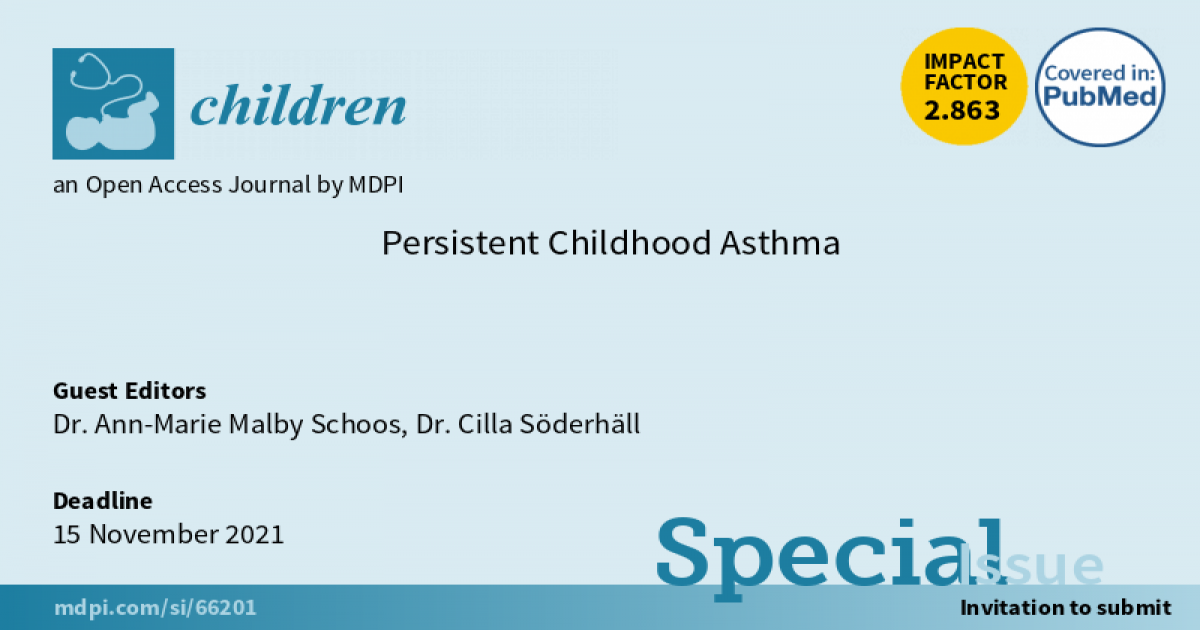Persistent Childhood Asthma
A special issue of Children (ISSN 2227-9067). This special issue belongs to the section "Pediatric Pulmonary and Sleep Medicine".
Deadline for manuscript submissions: closed (15 November 2021) | Viewed by 15039

Special Issue Editors
Interests: allergy; allergy diagnostics; asthma; allergic rhinitis; eczema; immunology
Special Issues, Collections and Topics in MDPI journals
Special Issue Information
Dear Colleagues,
Asthma is the most common chronic disease in children and the cause of great distress for both the children and their families. Various overlapping phenotypes exist, complicating aligned research in the field and meaningful, personalized treatment of the disease. Young children are particularly diverse with numerous and variable phenotypic presentations in early life that correspond to different outcomes. Despite the high reported rates of remission of asthma, the disease is usually considered as treatable but not curable once present. Understanding of the determinants that affect the course of diagnosed asthma, e.g., the avoidance of environmental or occupational exposures, is therefore important for tertiary prevention, since asthma persistence is associated with frequent and severe symptoms and with the development of impaired lung function. Asthma treatment guidelines have proven useful in standard care and the reduction of adverse outcomes in patients with asthma; however, the phenotypic heterogeneity within the disorder indicates the need for personalized medicine as opposed to a one-size-fits-all treatment approach.
The goal of this Special Issue is to provide an improved understanding of the phenotypes of persistent asthma (prevalence, comorbidities, lung function, response to treatment, etc.) and also to investigate the impact of genetic and environmental exposures in order to elucidate the possibility of tertiary prevention.
Dr. Ann-Marie Malby Schoos
Dr. Cilla Söderhäll
Guest Editors
Manuscript Submission Information
Manuscripts should be submitted online at www.mdpi.com by registering and logging in to this website. Once you are registered, click here to go to the submission form. Manuscripts can be submitted until the deadline. All submissions that pass pre-check are peer-reviewed. Accepted papers will be published continuously in the journal (as soon as accepted) and will be listed together on the special issue website. Research articles, review articles as well as short communications are invited. For planned papers, a title and short abstract (about 100 words) can be sent to the Editorial Office for announcement on this website.
Submitted manuscripts should not have been published previously, nor be under consideration for publication elsewhere (except conference proceedings papers). All manuscripts are thoroughly refereed through a single-blind peer-review process. A guide for authors and other relevant information for submission of manuscripts is available on the Instructions for Authors page. Children is an international peer-reviewed open access monthly journal published by MDPI.
Please visit the Instructions for Authors page before submitting a manuscript. The Article Processing Charge (APC) for publication in this open access journal is 2400 CHF (Swiss Francs). Submitted papers should be well formatted and use good English. Authors may use MDPI's English editing service prior to publication or during author revisions.
Keywords
- asthma
- children
- phenotypes
- persistence
- remission
- severity
- lung function
- treatment
- tertiary prevention
- comorbidities
- exposures
- genetics
- epigenetics
Benefits of Publishing in a Special Issue
- Ease of navigation: Grouping papers by topic helps scholars navigate broad scope journals more efficiently.
- Greater discoverability: Special Issues support the reach and impact of scientific research. Articles in Special Issues are more discoverable and cited more frequently.
- Expansion of research network: Special Issues facilitate connections among authors, fostering scientific collaborations.
- External promotion: Articles in Special Issues are often promoted through the journal's social media, increasing their visibility.
- e-Book format: Special Issues with more than 10 articles can be published as dedicated e-books, ensuring wide and rapid dissemination.
Further information on MDPI's Special Issue polices can be found here.







